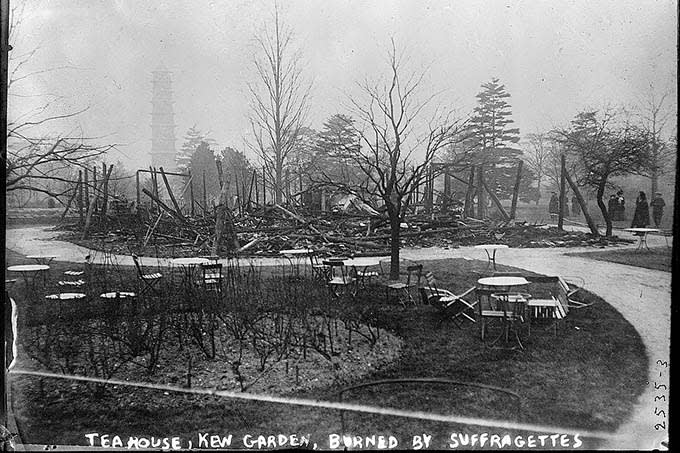Top Facts about Kew Gardens
Founded in 1840, The Royal Botanic Gardens at Kew , commonly known as Kew Gardens, is one of the most extensive and important botanical gardens in the world.
Wondering where is Kew Gardens located? It's a stunning sanctuary less than 30 minutes from central London, offering a perfect escape from the city buzz. Housing the "largest and most diverse botanical and mycological collections" globally, this UNESCO World Heritage Site is also one of London's most popular attractions.
What is Kew Gardens all about, you ask? Well, it includes more than 50,000 different plants in its living collection and over 7 million preserved specimens. It's not just a pretty space; it's a veritable treasure trove of plant-based knowledge, with over 750,000 volumes and illustrations contained in its library.
Discover more about this historical botanical landmark with some of our favourite facts about Kew Gardens below.

Kew Gardens- A Stroll Through Time
A little tidbit on the history of Kew Gardens: It's been around for quite a while! Its growth and development over the years have made it one of the famous gardens in London and indeed, the world.
1. The world's oldest pot plant resides at Kew
Housed inside the famous Palm House, the world's oldest pot plant, a huge Jurassic cycad (Encephalartos altensteinii) originally came to Kew in 1775. Plant-hunter, Frances Masson, collected the specimen during one of Captain Cook's voyages from the Eastern Cape of South Africa.

2. It's home to the smallest royal palace in the country
After a decade-long restoration project, the Grade I listed Kew Palace was reopened in 2006. The smallest of British royal residences, it was a popular getaway of George III (1760 - 1820). The same size as a small manor house, the palace was gifted to the people by Queen Victoria in 1837. Kew Gardens not just one of the best gardens in London, but also a royal one at that.

3. It has its own police force
For over 150 years, Kew Gardens has had its own police force responsible for on-site security. Established in the mid-1840s, it initially consisted of part-time gardeners and veterans from the Crimean War.
The Kew Constabulary originally possessed the same powers as the Metropolitan Police. This meant they were permitted to exercise their force in most London parks, including Battersea Park and Parliament Square.
As of 2022, the Kew Constabulary has 20 members of staff and one vehicle, making it one of the smallest police forces in the world. They ensure the security of this world-renowned botanic gardens London destination.

4. Suffragettes burned the Tea House down
On 20 Februrary 1913, Suffragettes Lilian Lenton and Olive Wharry burned down the Tea House at Kew Gardens in one of a number of arson attacks in the capital. After being caught, they were sentenced to 18-months at Holloway prison.
During their incarceration, they both went on hunger strike. They ended up being released within a month.

5. The tube station has its own pub
Getting to Kew Botanical Gardens is even more fun knowing that Kew Gardens station has its very own pub! Previously called The Railway, The Tap on the Line pub was reopened in 2013. There still is a door near the bar that leads directly to platform one, but it's no longer open to the public.

6. It has part of old London Bridge
In 1968, the American entrepreneur Robert P McCaulloch bought the 19th century London Bridge and attempted to move it to Arizona’s Lake Havasu. He thought he was buying Tower Bridge, but alas, no.
Around 200 granite blocks didn't make the trip across the Atlantic. Four of those blocks were taken by Kew Gardens and placed on the banks of the big lake near the Sackler Crossing.

7. Commemorative coins
Kew Gardens celebrated its 250th anniversary in 2009 and to commemorate this event, the Royal Mint released a commemorative 50p coin. Only 210,000 Kew coins were minted. This resulted in them soaring in value, selling for over 100 times their monetary worth.

8. Climate control
Discover 10 different climate zones at the Princess of Wales conservatory. From the dry tropics and wet tropics to eight smaller micro-climates, the conservatory ensures that each set of plants' needs are met.

9. Rare heist
In 1987, the world's smallest water-lily (Nymphaea thermarum) was discovered in Mashyuza, Rwanda. Conservationists saved the plant from extinction after it was grown from seeds at Kew Gardens. In 2014, one of these rare water lilies was stolen from the Princess of Wales Conservatory.

10. An explosive history
During the Second World War, the Great Pagoda became the perfect place to test the aerodynamics of bombs in secret.
Around 30 high-explosives dropped onto the gardens during the Blitz and the Herbarium, Temperate Houses, Palm House and Waterlily House suffered damage.
Consider adding the Royal Botanic Gardens, Kew to your itinerary during your trip with The London Pass®. You'll make great savings on combined admission vs. paying at the gate, and your pass includes entry to dozens more top attractions in the city!